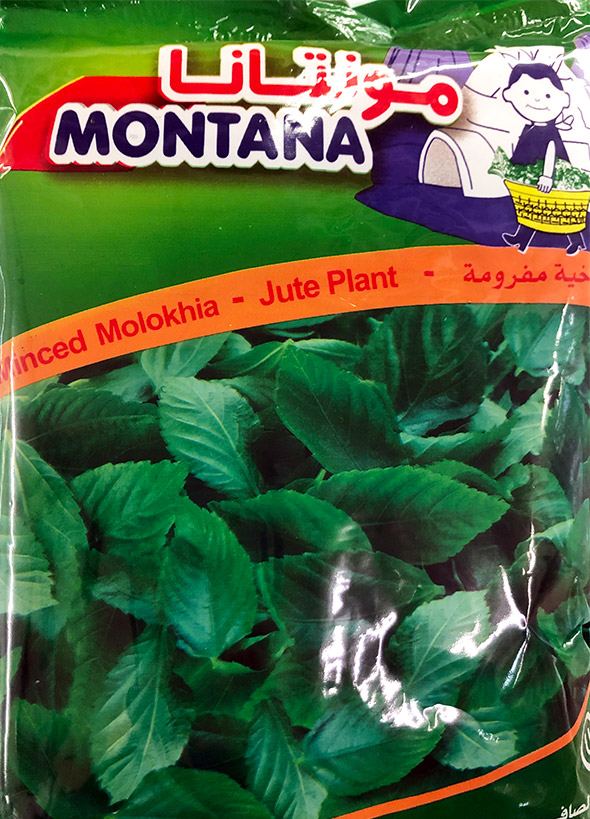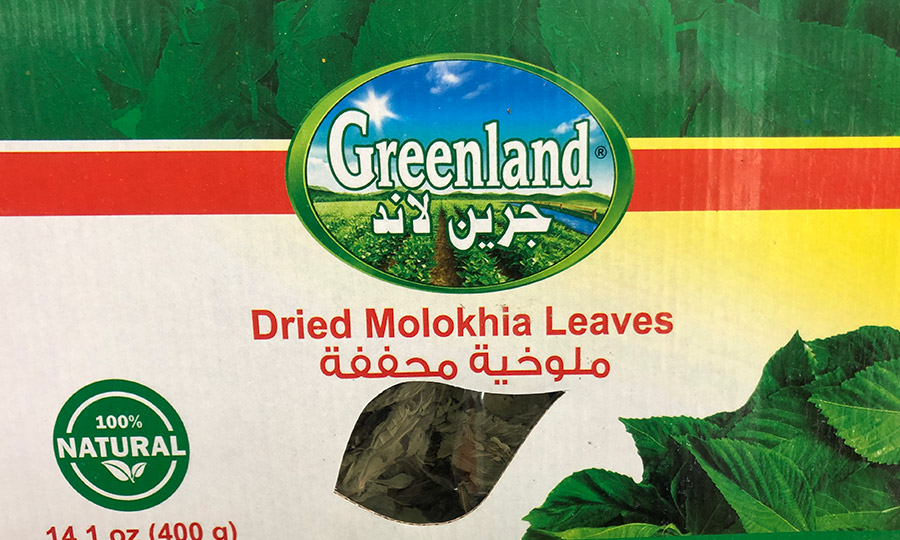This article introduces readers to Jew’s Mallow, a nutritious Middle Eastern super-vegetable and superfood, summarizing its many benefits for nutrition, beauty and health. It also discusses how to take Jew’s Mallow as a nutritional supplement, and how to cook with it.
I walked into the Café Istanbul, a local Middle Eastern supermarket here in Albuquerque, New Mexico, and found boxes of these dried leaves – the box said that they were Mallow Leaves. But they looked quite different than the usual Mallow leaves that I had been accustomed to; in contrast to the usual Mallow leaves growing as an edible weed in the back yard, these leaves were longer and more pointed – so they were obviously a different kind of Mallow. Nasser, the store’s owner, told me that they were called Molokhia when I asked what the Arabic name for them was. I learned later that they were called Jew’s Mallow, and their scientific name is Corchoris olitorius; the vegetable superfood has also been called Jute Mallow, since the plant grows very tall, up to 4 meters (13 feet) tall, with very long stalks, which provide the Jute fiber for making ropes and twine. It is also called Egyptian Spinach because it is cultivated in the Nile Delta and tastes a lot like spinach. Another name for it is Bush Okra, because, like Okra, and ordinary Mallow, the plant is high in natural mucilage content, giving it a somewhat slimy feel on the tongue; it can be made into a thick, creamy soup as well.
Jew’s Mallow is such an ancient plant, both as a source of fiber for rope and twine, as well as a pot herb, or nutritious supervegetable, that botanists are at a loss when it comes to pinpointing exactly where the plant is indigenous to. Many say it is native to Egypt, and certainly records of its use in Egypt go way back to ancient times. One can easily imagine Jewish slaves being fed the plant, with its super-nutritious leaves keeping them going through all their backbreaking labor. Legends persist that Cleopatra used to eat a soup of the leaves every day, and that was her insider’s secret for maintaining her legendary beauty and youthful appearance. Even today, Jew’s Mallow figures prominently in Jewish cuisine; not only is it mentioned in the Old Testament (Job 6: 6 – 7), but it is also featured in books like Eat and Be Satisfied: A Social History of Jewish Food. Other contenders when it comes to the original land of origin for Jew’s Mallow range all the way from Africa, to the Middle East, to Southeast Asia.

Nutritional and Health Benefits of Jew’s Mallow
Jew’s Mallow is a real powerhouse when it comes to its nutritional content. First of all, the leaves are remarkably high in protein content for a vegetable – some 4.5 percent. 40 percent of the calories in Jew’s Mallow come from its protein content. The cooked leaves have virtually no fat or cholesterol, and are carbohydrate free. Jew’s Mallow is very high in fiber, which accounts for most of its mass, and contains about four times as much insoluble fiber as soluble fiber; the soluble fiber is its slimy mucilage content. Other nutritional and health benefits include the following:
One cup of Jew’s Mallow leaves contain the full RDA, or Recommended Daily Allowance, for vitamin C.
Jew’s Mallow has twice the potassium of broccoli, spinach and carrots.
Jew’s Mallow has three times the phosphorus of kale, and four times the Riboflavin (vitamin B2).
Jew’s Mallow has five times more calcium than spinach.
The dark green leaves of Jew’s Mallow are a rich source of Cryptoxanthin, a potent carotenoid, and are a rich source of beta carotene, or vegetarian vitamin A, as well.
Jew’s Mallow is high in Manganese, an essential mineral.
Although Jew’s Mallow is low in overall fat content, it is a rich source of Omega 3 fatty acids.
The health and therapeutic benefits of Jew’s Mallow are also quite remarkable, although my sources affirm that the clinical studies conducted to date are only preliminary, and much more clinical research needs to be done. Nevertheless, the preliminary findings suggest the following:
Jew’s Mallow lowered blood sugar in a human clinical trial.
Jew’s Mallow has demonstrated anti-cancer activity in laboratory research.
Jew’s Mallow demonstrated powerful anti-inflammatory effects in an animal study.
Jew’s Mallow protected rats against gastric lesions in another laboratory study; this makes sense, due to its high mucilage content, which has a soothing and protective emollient effect on the mucosa of the stomach and GI tract.
Other animal studies conducted on rats show that Jew’s Mallow reduced the toxic effects of lead poisoning and protected them against liver damage from obesity.

Avicenna on Jew’s Mallow
In his Canon of Medicine (Al Qanun fi-l Tibb), Avicenna, or Ibn Sina, calls Jew’s Mallow a kind of okra, and says that it has laxative properties, which would make sense, considering its high content of lubricating mucilage; he also says that it thins the blood. In terms of its tempera-ment, Jew’s Mallow, he says, is cold and moist in the first degree, or slightly cooling and moistening. The high moisture content of Jew’s Mallow, says Avicenna, makes it easily digestible. The cooling property of Jew’s Mallow also makes sense, because it does not seem to warm or stimulate the digestive or metabolic fires of the body when you eat it. Besides the usual Molokhia, Avicenna also mentions that there are other varieties of Jew’s Mallow, which go by other names, like Baqla Yahudia, which would make it more explicitly Jewish; it is hotter in temperament than ordinary Jew’s Mallow. Avicenna also says that Jew’s Mallow also has the property of constricting the tissues and channels of the body.
Avicenna tells us that Jew’s Mallow is useful in treating certain febrile diseases characterized by a deep, diffuse and spreading inflammation or rash of the skin and mucous membranes. Chew Jew’s Mallow for treating mouth and tongue ulcers. A poultice of Jew’s Mallow is very useful for treating head ulcers. Both the leaves and flowers of Jew’s Mallow, says Avicenna, will help in the production of breast milk in nursing mothers, whereas a tea made from the leaves will help to soothe coughs that are due to excess heat and dryness. The flowers of Jew’s Mallow are useful for treating ulcers of the kidneys or bladder. The branches of wild Jew’s Mallow are useful for treating the intestines and the bladder, having the ability to loosen the bowels and relieve acute abdominal pain. The main things to take into consideration when using Jew’s Mallow as a natural remedy, it seems to me, are its soothing, moistening and emollient properties, which also seem to have the property of liquefying, through their high moisture content, thick or viscous humors like blood and phlegm. The cooling properties of Jew’s Mallow help to bring down certain kinds of fevers, rashes and swellings. Another interesting fact about Jew’s Mallow that Avicenna mentions is that, like the Sunflower, the plant rotates to face towards the sun.
Using Jew’s Mallow, and Cooking With It
One of the first things I discovered about Jew’s Mallow when I powdered up the dried leaves in my electric coffee grinder and put some on my tongue as an herbal superfood, getting ready to wash it back with water, was that the stuff was very sticky, and clumped together, due to its high mucilage content. And so, I found myself having to pick gelatinous globs of Jew’s Mallow from between my teeth and gums after taking it in this manner. Nevertheless, I feel that it could be homogenized in a blender if you started with just the water whirling around in the blender and then added the powder bit by bit; you could also blend Jew’s Mallow powder into smoothies in this manner, if you didn’t mind the dark green color. Or, the blended mixture of Jew’s Mallow powder and water could simply be put into a saucepan and heated up into a rich, creamy soup – minus the cholesterol-rich cream, of course. Flavor it with a little soy sauce and olive oil, and it would taste great. Or, you could mix the Jew’s Mallow powder with water and knead it into a dough, making it into Jew’s Mallow balls, similar to meatballs, and then steam them or sauté them; heck, you could even deep fry them like Falafel.
I also discovered, on a recent visit to the Café Istanbul, that Jew’s Mallow was available in the freezer, in the frozen vegetables section, similar to frozen spinach – just cook it up like you would ordinary frozen spinach. Or, you could take the whole dried leaves and put them in a bowl, covering them with water. Wait a few minutes and the dried leaves will soak up the water; you can then put them in a steamer, with other vegetables, or even meat, if you wish – or put them in stews. Because of their rich, savory flavor, Jew’s Mallow leaves are often cooked up with chicken in Middle Eastern cuisine; the flavors complement each other very well. In short, there are a whole host of ways that you can cook with Jew’s Mallow, known as Molokhia / Mulukhia / Moroheiya in the Middle East, and enjoy its great health and nutrition benefits. A Japanese company has even blended Jew’s Mallow into noodles.
The Café Istanbul is located at 1410 Wyoming Blvd., NE Suite F, Albuquerque, New Mexico 87112, in a strip mall near the corner of Wyoming and Constitution. Their telephone number is (505)294-9900. My heartfelt thanks go out to Nasser and the Café Istanbul for introducing me to this wonderful, nutritious vegetable and herbal superfood.
Sources:
- superfoodly.com/
- stylecraze.com
- The Canon of Medicine, Vol. II: Natural Pharmaceuticals by Avicenna, translated and compiled by Laleh Bakhtiar, pp. 596 – 599. @ 2012 by Laleh Bakhtiar, published by Great Books of the Islamic World, Inc., Distributed by Kazi Publications, Inc., Chicago, IL, USA
DISCLAIMER: The information in this article is for educational purposes only, for general health maintenance and prevention, and is not intended to diagnose or treat any medical disease or condition. The reader assumes all personal responsibility and liability for the application of the information contained in this article, and is advised to seek the services of a physician or licensed healthcare practitioner should his or her symptoms or condition persist or worsen.
